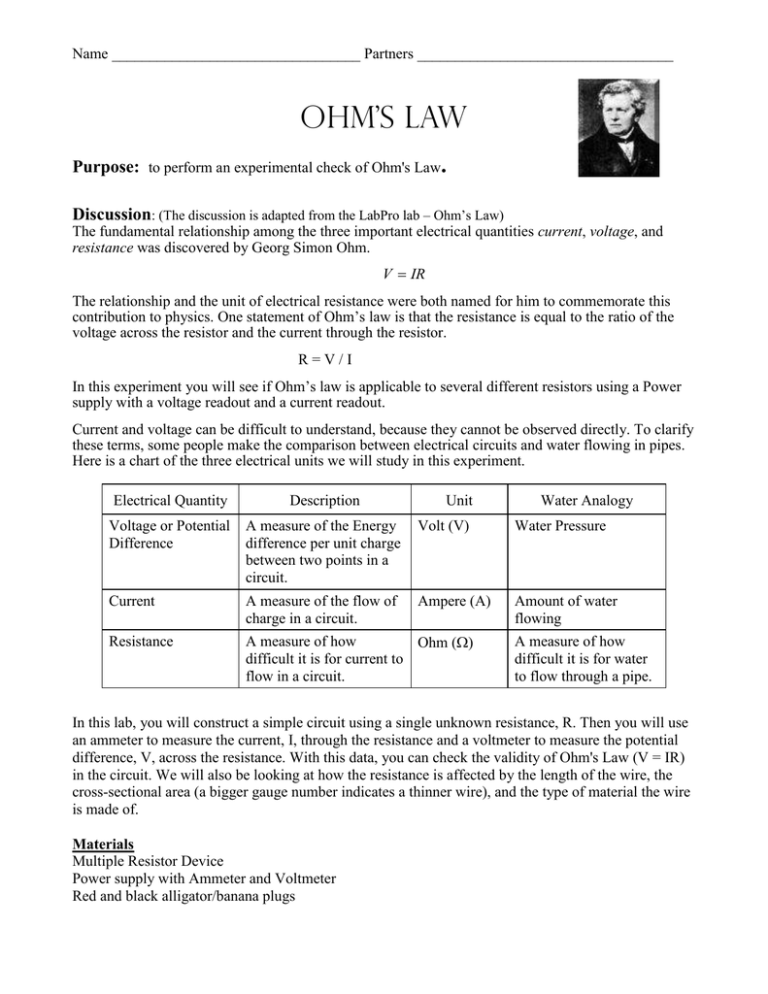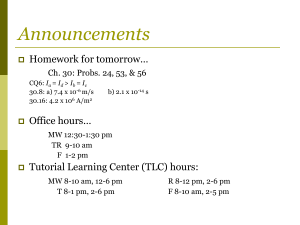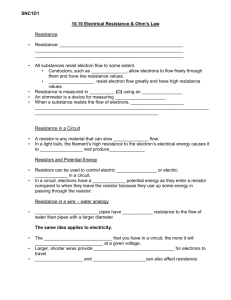Ohm's Law
advertisement

Name _________________________________ Partners __________________________________ Ohm's Law Purpose: to perform an experimental check of Ohm's Law. Discussion: (The discussion is adapted from the LabPro lab – Ohm’s Law) The fundamental relationship among the three important electrical quantities current, voltage, and resistance was discovered by Georg Simon Ohm. V IR The relationship and the unit of electrical resistance were both named for him to commemorate this contribution to physics. One statement of Ohm’s law is that the resistance is equal to the ratio of the voltage across the resistor and the current through the resistor. R=V/I In this experiment you will see if Ohm’s law is applicable to several different resistors using a Power supply with a voltage readout and a current readout. Current and voltage can be difficult to understand, because they cannot be observed directly. To clarify these terms, some people make the comparison between electrical circuits and water flowing in pipes. Here is a chart of the three electrical units we will study in this experiment. Electrical Quantity Description Unit Water Analogy Voltage or Potential Difference A measure of the Energy difference per unit charge between two points in a circuit. Volt (V) Water Pressure Current A measure of the flow of charge in a circuit. Ampere (A) Amount of water flowing Resistance A measure of how Ohm () difficult it is for current to flow in a circuit. A measure of how difficult it is for water to flow through a pipe. In this lab, you will construct a simple circuit using a single unknown resistance, R. Then you will use an ammeter to measure the current, I, through the resistance and a voltmeter to measure the potential difference, V, across the resistance. With this data, you can check the validity of Ohm's Law (V = IR) in the circuit. We will also be looking at how the resistance is affected by the length of the wire, the cross-sectional area (a bigger gauge number indicates a thinner wire), and the type of material the wire is made of. Materials Multiple Resistor Device Power supply with Ammeter and Voltmeter Red and black alligator/banana plugs Name _________________________________ Partners __________________________________ Procedure: Before Experimenting: Use the resistor device to fill in the data table of resistor information. You will complete the table by calculating the resistance of each resistor as you work through the experiment. Procedure: The effect of length of a wire and resistance. 1. Turn the current knob all the way to the right. (DO NOT TURN THIS KNOB AGAIN FOR THE ENTIRE EXPERIMENT) 2. Turn the course voltage knob to the left. 3. Take a red wire that has a banana plug and alligator clip. Plug in the banana end to the power supply to the red port on the power supply. Plug the black wire into the black port. 4. Attach the alligator clips to the ends of the no. 1 resistor. (Red on one, Black on one) 5. Turn on the power supply and notice how you can adjust the voltage a large amount with the “course” knob and you can make small adjustments with the “fine” knob. Adjust the voltage to take 5 readings of voltage and current between 0 and 2 V. Record your data in the table. 6. Use the 2nd statement of Ohm’s Law from the Introduction to calculate the resistance for each reading. Calculate the average of all the resistance readings and record that value in the “Resistor information” table. 7. Repeat step 5 and 6 for the no. 3 resistor. 8. Calculate your percent error. Resistor information Resistor Number Stated Resistance (ohms) Measured Resistance (ohms) Percent Error 1 2 3 Circuit Diagrams: Below is the circuit diagram that would be used to represent each of these simple circuits. Notice that the voltage source has one line shorter than the other. By convention, the shorter line represents the negative terminal of the voltage source. Name _________________________________ Partners __________________________________ Data Tables for Procedure 1 Voltage Resistor 1 Current Resistance Resistor 2 Current Resistance Resistor 3 Current Resistance Average Resistance Voltage Average Resistance Voltage Average Resistance Name _________________________________ Partners __________________________________ Analysis and Conclusion: 1. From the data in procedure 1, create a graph that illustrates the relationship between voltage and current. Use voltage for the vertical axis and current on the horizontal axis. (One graph, 3 lines). Do not “connect the dots” for each line. After you have plotted the data for a resistor, try to “eye” a best-fit straight line through the points. 2. Calculate the slope of each line. Label each with the slope. What does the slope represent? Does it agree with the calculated measurements? 3. Write out Ohm’s Law. Do all the resistors obey Ohm’s law conceptually? Explain. 4. What other factor may be affecting the data that may not make our results perfect? To turn in: Write a formal lab report detailing the experiment. This report must be typed. The report should include separate sections for the following: Purpose, Hypothesis, Materials, Procedure, Safety Precautions, Data, Analysis, Conclusions and Error Analysis. Each section should be identified by a bolded heading.





